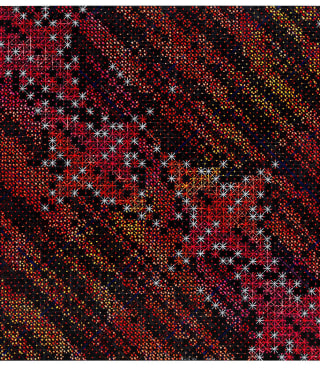Yu-ping Luk meditates upon a major new acquisition of Chinese abstract art
The album 70 Circles by the artist Ding Yi (b. 1962) opens with a small circle in the middle of a blank page. The circle is composed of layers of crosses, grids and dots in greyscale, like a piece of woven fabric. As we move through the pages, the circles vary in numbers and change in size, pattern and configuration. The painting conveys a sense of matter evolving, waxing and waning. In some ways, the pared-down quality of this album is atypical of Ding Yi’s works. The Shanghai-based artist is best known for his large-scale paintings on stretched fabric, or more recently plywood, that are almost visually overwhelming in their physical build-up of materials, patterns and colours that cover the entirety of the painting surface. However, 70 Circles is also unmistakably by Ding Yi in that it uses ‘+’ and ‘x’ and the resulting grid as its basic building blocks, which have been the artist’s signature style since the 1980s. With few exceptions (this album being one of them), Ding Yi’s paintings are always named ‘Appearances of Crosses’ in reference to these marks. Unrelated to the cross in the Judeo-Christian tradition, Ding Yi’s ‘+’ and ‘x’ are literal marks that are unfettered by meaning and tradition.
Ding Yi’s turn to abstraction in the 1980s occurred in the midst of rapid socio-economic changes in Shanghai and China more broadly. His decision to devote himself to an extremely simplified visual idiom can be interpreted as a response to the legacies of the Cultural Revolution (1966–76) as well as the sudden influx of artistic and cultural influences from outside China. In a time of intense and confusing change, Ding Yi sought an independent path, which he has carried on diligently in the decades that follow regardless of trends. Through the repeated use of ‘crosses’, Ding Yi explores the possibilities of colour, composition, material and techniques, as well as his perception of the highly urbanised environment of the Shanghai metropolis.
As 70 Circles was painted gradually in the privacy of Ding Yi’s home rather than in his studio, it arguably reveals another facet of the artist, one that engages with history and the passage of time. Elements linked to traditional Chinese brush-and-ink painting that Ding Yi studied in art school are observable in the work. The album with its brocade cover, inscribed title slip and sheets of rice or xuan paper is one of the formats for traditional Chinese painting. In the concertina form, the album can be fully opened like a handscroll. Whether going through the painting page by page or in its entirety, the format requires the viewer to experience the work slowly and in detail, section by section.
Paper has been used for writing and painting in China since the early centuries, while the painting’s acrylic and pencil marks in greyscale are reminiscent of ink, their translucency revealing the artist’s hand and creative process. The series of circles with their evolving patterns in the painting also recall Daoist philosophical ideas, where nature is perceived to be in a constant state of flux while following an underlying order. Although the title of the painting 70 Circles refutes any claims to meaning, Ding Yi has nonetheless seamlessly combined his modernist approach with his own Chinese cultural heritage in this work, inviting viewers to reflect on the significance of the past in the present, and the potential for the micro to reveal the universal.
The acquisition of Ding Yi’s 70 Circles, purchased with the Brooke Sewell Permanent Fund, is part of continued curatorial efforts to develop the contemporary Chinese collections at the British Museum. The album will go on display in a future rotation in the Sir Joseph Hotung Gallery of China and South Asia (Room 33).
Ding Yi: 70 Circles in the British Museum Magazine
British Museum Magazine, 29 October 2018

